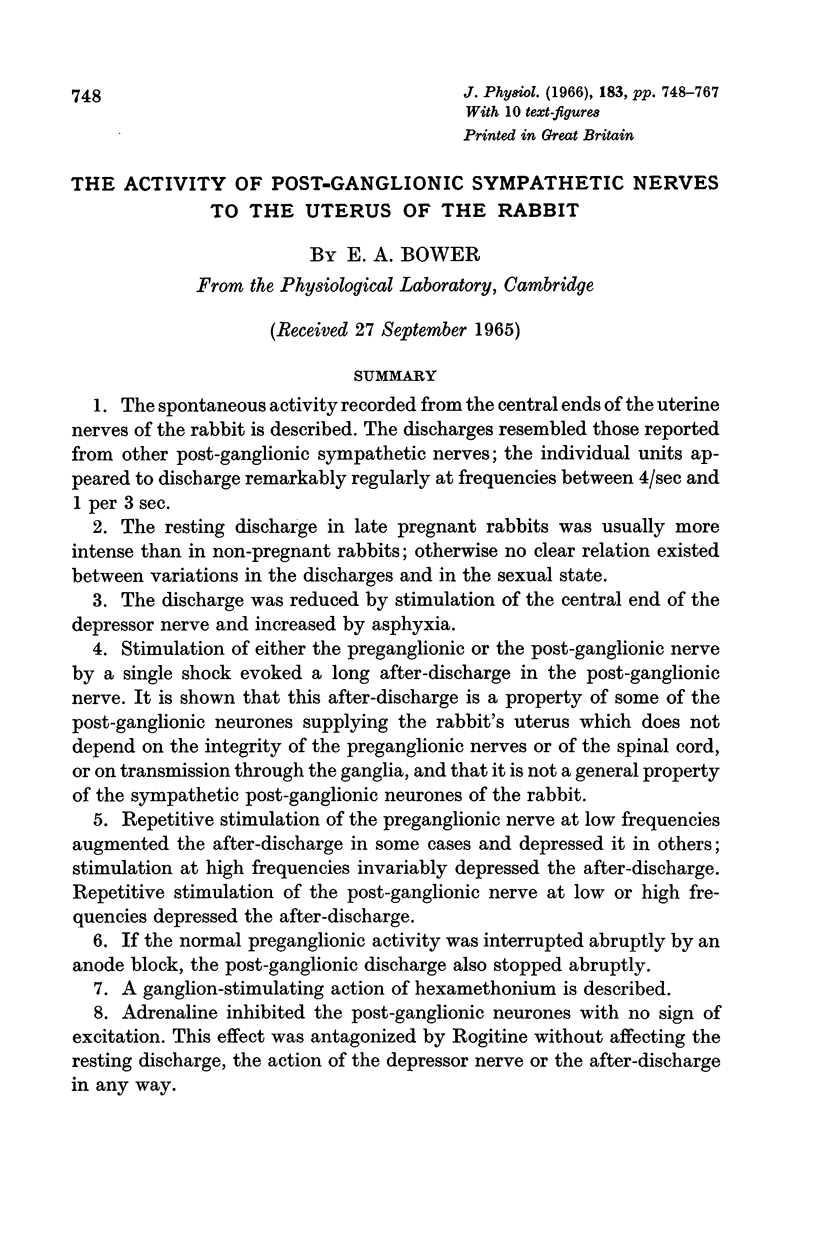Abstract
1. The spontaneous activity recorded from the central ends of the uterine nerves of the rabbit is described. The discharges resembled those reported from other post-ganglionic sympathetic nerves; the individual units appeared to discharge remarkably regularly at frequencies between 4/sec and 1 per 3 sec.
2. The resting discharge in late pregnant rabbits was usually more intense than in non-pregnant rabbits; otherwise no clear relation existed between variations in the discharges and in the sexual state.
3. The discharge was reduced by stimulation of the central end of the depressor nerve and increased by asphyxia.
4. Stimulation of either the preganglionic or the post-ganglionic nerve by a single shock evoked a long after-discharge in the post-ganglionic nerve. It is shown that this after-discharge is a property of some of the post-ganglionic neurones supplying the rabbit's uterus which does not depend on the integrity of the preganglionic nerves or of the spinal cord, or on transmission through the ganglia, and that it is not a general property of the sympathetic post-ganglionic neurones of the rabbit.
5. Repetitive stimulation of the preganglionic nerve at low frequencies augmented the after-discharge in some cases and depressed it in others; stimulation at high frequencies invariably depressed the after-discharge. Repetitive stimulation of the post-ganglionic nerve at low or high frequencies depressed the after-discharge.
6. If the normal preganglionic activity was interrupted abruptly by an anode block, the post-ganglionic discharge also stopped abruptly.
7. A ganglion-stimulating action of hexamethonium is described.
8. Adrenaline inhibited the post-ganglionic neurones with no sign of excitation. This effect was antagonized by Rogitine without affecting the resting discharge, the action of the depressor nerve or the after-discharge in any way.
Full text
PDF



















Selected References
These references are in PubMed. This may not be the complete list of references from this article.
- Adrian E. D., Bronk D. W., Phillips G. Discharges in mammalian sympathetic nerves. J Physiol. 1932 Feb 8;74(2):115–133. doi: 10.1113/jphysiol.1932.sp002832. [DOI] [PMC free article] [PubMed] [Google Scholar]
- Bower E. A. The characteristics of spontaneous and evoked action potentials recorded from the rabbit's uterine nerves. J Physiol. 1966 Apr;183(3):730–747. doi: 10.1113/jphysiol.1966.sp007895. [DOI] [PMC free article] [PubMed] [Google Scholar]
- Bülbring E., Burn J. H. An action of adrenaline on transmission in sympathetic ganglia, which may play a part in shock. J Physiol. 1942 Nov 30;101(3):289–303. doi: 10.1113/jphysiol.1942.sp003983. [DOI] [PMC free article] [PubMed] [Google Scholar]
- Bülbring E. The action of adrenaline on transmission in the superior cervical ganglion. J Physiol. 1944 Jun 15;103(1):55–67. doi: 10.1113/jphysiol.1944.sp004062. [DOI] [PMC free article] [PubMed] [Google Scholar]
- ECCLES R. M., LIBET B. Origin and blockade of the synaptic responses of curarized sympathetic ganglia. J Physiol. 1961 Aug;157:484–503. doi: 10.1113/jphysiol.1961.sp006738. [DOI] [PMC free article] [PubMed] [Google Scholar]
- Eccles J. C. The nature of synaptic transmission in a sympathetic ganglion. J Physiol. 1944 Jun 15;103(1):27–54. doi: 10.1113/jphysiol.1944.sp004061. [DOI] [PMC free article] [PubMed] [Google Scholar]
- FOLKOW B. Impulse frequency in sympathetic vasomotor fibres correlated to the release and elimination of the transmitter. Acta Physiol Scand. 1952;25(1):49–76. doi: 10.1111/j.1748-1716.1952.tb00858.x. [DOI] [PubMed] [Google Scholar]
- IGGO A., VOGT M. Preganglionic sympathetic activity in normal and in reserpine-treated cats. J Physiol. 1960 Jan;150:114–133. doi: 10.1113/jphysiol.1960.sp006377. [DOI] [PMC free article] [PubMed] [Google Scholar]
- JOB C., LUNDBERG A. On the significance of post- and pre-synaptic events for facilitation and inhibition in the sympathetic ganglion of the cat. Acta Physiol Scand. 1953 Mar 31;28(1):14–28. doi: 10.1111/j.1748-1716.1953.tb00956.x. [DOI] [PubMed] [Google Scholar]
- LUNDBERG A. Adrenaline and transmission in the sympathetic ganglion of the cat. Acta Physiol Scand. 1952 Sep 10;26(2-3):252–263. doi: 10.1111/j.1748-1716.1952.tb00908.x. [DOI] [PubMed] [Google Scholar]
- MARGUTH H., RAULE W., SCHAEFER H. Aktionsströme in zentrifugalen Herznerven. Pflugers Arch. 1951 Jan;254(3):224–245. doi: 10.1007/BF00413114. [DOI] [PubMed] [Google Scholar]
- NISIDA I., OKADA H., NAKANO O. The activity of the ciliospinal centers and their inhibition in pupillary light reflex. Jpn J Physiol. 1960 Feb 29;10:73–84. doi: 10.2170/jjphysiol.10.73. [DOI] [PubMed] [Google Scholar]
- OKADA H., KADO N., NISIDA I. The effects of stimulation of the carotid sinus baroreceptors upon the activity of the long ciliary nerve. Jpn J Physiol. 1961 Dec 15;11:612–618. doi: 10.2170/jjphysiol.11.612. [DOI] [PubMed] [Google Scholar]
- PATON W. D. M., ZAIMIS E. J. Paralysis of autonomic ganglia by methonium salts. Br J Pharmacol Chemother. 1951 Mar;6(1):155–168. doi: 10.1111/j.1476-5381.1951.tb00631.x. [DOI] [PMC free article] [PubMed] [Google Scholar]
- PERRY W. L., REINERT H. The effects of preganglionic denervation on the reactions of ganglion cells. J Physiol. 1954 Oct 28;126(1):101–115. doi: 10.1113/jphysiol.1954.sp005196. [DOI] [PMC free article] [PubMed] [Google Scholar]


